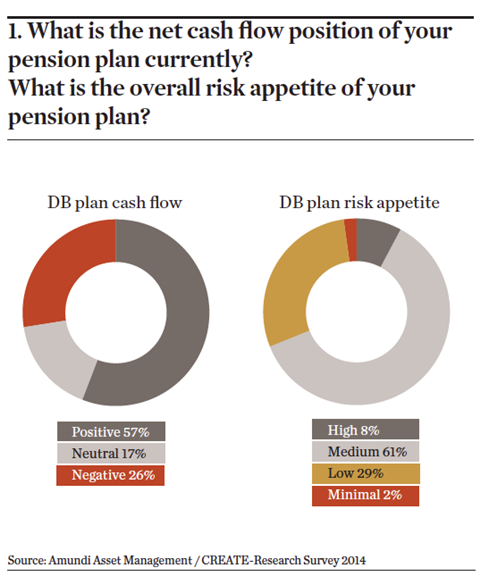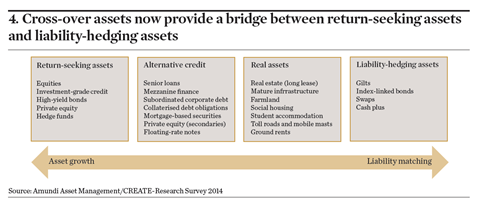Two of the four worst bear markets of the last century rocked the world of investing over just seven years in the last decade. They sidelined conventional wisdom on risk premia and diversification.
This article presents asset selection choices, as plans move from accumulation to decumulation phase. It presents three distinct yet overlapping approaches: one single-mindedly product-focused and apparently indifferent to the transition; another more time-focused and in tune with the different stages of plan decumulation; and the last more asset-liability focused, straddling both accumulation and decumulation phases.
Maturing liabilities are driving up the cash flow needs of pension plans while reducing their risk appetites, according to some 50% of pension plans in the new survey by Amundi Asset Management and CREATE-Research titled Alpha behind Alpha*.
Currently, 26% of plans are in cash flow-negative territory, 17% in neutral territory and 57% in positive territory (figure 1, left chart).
In fact, most plans in Europe are already in their run-off phase, with the first and the largest cohort of baby boomers entering retirement. Yet, some are still in positive cash flow-positive territory, either because the number of their retirees is still small or their portfolios are delivering good income.
As we shall see later, this has made it essential to have an asset mix that delivers multiple goals – return-enhancing assets to boost the funding levels, income assets to provide capital protection, cash flow assets to honour contractual liabilities, and real assets to provide inflation protection.
This eclectic mix is further reflected in the fee structure. Our survey shows that nearly 90% of plans use market-based benchmarks, since 60-80% of their assets are allocated to long-only funds. Yet, around 50% also use cash flow-based benchmarks and 40% use absolute return benchmarks. Despite the variety of goals, the beat-the-market mentality remains ever present.

Turning to risk appetite, 90% of plans have either a medium or a low appetite (figure 1,). A variety of instruments are used to hedge portfolio risks either implicitly or explicitly.
The implicit ones rely on greater asset class diversification (cited by 78%), risk factor-based diversification (49%), duration management (48%) and liability-driven investing (41%). The explicit ones rely on inflation, interest rate and mortality hedges (30%), tail-risk hedges (18%) and option contracts with asymmetric bets (9%).
This lower popularity of explicit hedges is attributed to their cost, which can be a drag on performance. In contrast, there is a strong preference for discretionary hedges around equity and credit portfolios to capture or avoid short-term momentum, sentiment and macro events. The emerging risk culture relies on a more open dialogue between trustees and their full-time executives. It also marks a shift from an asset-based measure of risk (volatility) to a liability-based measure (cash flow).
End of the one-size-fits-all approach
Prior to 2000, when risk premia were more predictable, pension plans followed a formulaic approach, often using a 60/40 split between equities and bonds. Since then, as time-honoured investment assumptions have been sidelined, asset allocation has become more heterogeneous across Europe. In this context, just under 18 asset classes have been identified in our report. The top ones are:
• Global equities (cited by 65% of respondents)
• Real estate (48%)
• Investment-grade bonds (41%)
• High-yield bonds (35%)
• Emerging market equities (34%)
• Infrastructure (33%)
At surface level, the asset preferences conceal more than they reveal. Behind them lie three clear approaches, each with its own imperative.
The first approach is product-focused. This approach invests in equities and bonds through a hybrid blend of single strategies. Some also use risk parity; others use long-short funds. The main users are plans with positive cash flows and/or assets of less than €10bn, with limited governance expertise and skill sets. This approach does not clearly discriminate between the accumulation and decumulation phases. Around 40% of plans use this approach.
In contrast, the second approach is time-focused and covers three distinct stages of the decumulation phase (figure 3). It is being implemented by plans already in the run-off phase, with negative or neutral cash flows. Around 30% of plans rely on this approach. Their asset choices vary by three stages.
High returns are no longer the be-all and end-all, as liabilities mature. Hence, in the early stage they target inflation protection via real estate and infrastructure; capital protection via long Treasuries and index-linked bonds; high income via alternative credit; and capital growth via deep value or high-dividend equities.

This mix is indicative, not definitive; it varies between plans. Overall, it aims to strike a balance between asset growth and liability matching; between risky assets and less risky assets; between high returns and capital buffers; and between financial repression resulting from low real yields and sequences of returns risk resulting from the inordinate time taken to recoup the loses after big market events.
These balancing acts are essential. In none of the European countries have the average funding levels yet reverted to their pre-crisis highs. Indeed, there are growing worries that tighter regulation will hamper plans’ abilities to harness risk premia as and when they emerge.
The rise of cross-over assets
The time-focused approach described above centres on the decumulation phase.
In contrast, the third approach that is LDI-focused straddles both accumulation and decumulation phases of the defined benefit (DB) pension plans. It progressively immunises the risks inherent in their portfolios, as and when the funding levels improve.
With the adoption of mark-to-market accounting rules in the middle of the past decade, the majority of DB plans across Europe have separated their risk-hedging assets from their return-seeking assets (figure 4, assets at two extremes).
Hedging assets aim to mimic a plan’s liability profile. While correlating with liabilities, they provide credit spread, liquidity and duration. Return-seeking assets, on the other hand, aim to plug the deficits. They target liability-plus returns, low asset class correlation and broad diversification. Some plans use leverage to spice up returns in both groups.
Notably, the interaction between them follows a specially crafted glide path that triggers gradual asset shifts from risky to less risky assets as plan deficits decline over time. However, since the 2008 crisis, three problems have emerged.
First, in the return-seeking group, equities have proved ultra volatile and alternatives have delivered sub-par returns.
Second, in the hedging category, there has been a 70% contraction in AAA-rated bonds since 2011. The quantitative easing programmes have also swamped the stock of sovereign debt held by the public.
For example, the Bank of England now holds 75% of index-linked Gilts. The resulting excess demand is not expected to be met until 2035. Besides, today’s valuations are distorted by central bank action: nobody knows the fair price of the bonds of indebted nations.
Third, many plans have been obliged to raise their funding targets at every trigger point in their glide path, so as to protect against
sovereign default or other counterparty risks inherent in their hedging assets. Many worry that rates might fall again or remain low for a long time, wrecking their well-crafted glide paths.

These concerns have intensified the search for the crossover assets with equity-like returns and bond-like features (figure 4, the two asset groups centre). For example, both senior loans and mezzanine finance have delivered the best return in the fixed-income space in the past two years. These and other substitute assets are now viewed as crossover assets.
As surrogates, they complement other asset classes chosen along the glide paths. Their demand will grow as the search for yield intensifies and fears of sovereign debt crises lurk in the background.
These three approaches speak to a simple imperative: in the run-off phase, pension plans pay more attention to their immediate needs rather than peer herding.
Conclusion
Pension plans are transitioning to liability management, which is a whole new exercise. They have been forced to explore new horizons in the belief that markets are unlikely to normalise any time soon, while they advance in negative cash flow territory. Ageing demographics will exert a growing influence henceforth.
*http://research-center.amundi.com
Pierre Cailleteau is the global head of institutional and sovereign clients at Amundi Asset Management and Amin Rajan is CEO of CREATE-Research






































No comments yet